Cherokee vs Laotian Community Comparison
COMPARE
Cherokee
Laotian
Social Comparison
Social Comparison
Cherokee
Laotians
2,697
SOCIAL INDEX
24.5/ 100
SOCIAL RATING
243rd/ 347
SOCIAL RANK
8,033
SOCIAL INDEX
77.8/ 100
SOCIAL RATING
91st/ 347
SOCIAL RANK
Laotian Integration in Cherokee Communities
The statistical analysis conducted on geographies consisting of 213,652,083 people shows a mild positive correlation between the proportion of Laotians within Cherokee communities in the United States with a correlation coefficient (R) of 0.318. On average, for every 1% (one percent) increase in Cherokee within a typical geography, there is an increase of 0.003% in Laotians. To illustrate, in a geography comprising of 100,000 individuals, a rise of 1,000 Cherokee corresponds to an increase of 2.7 Laotians.
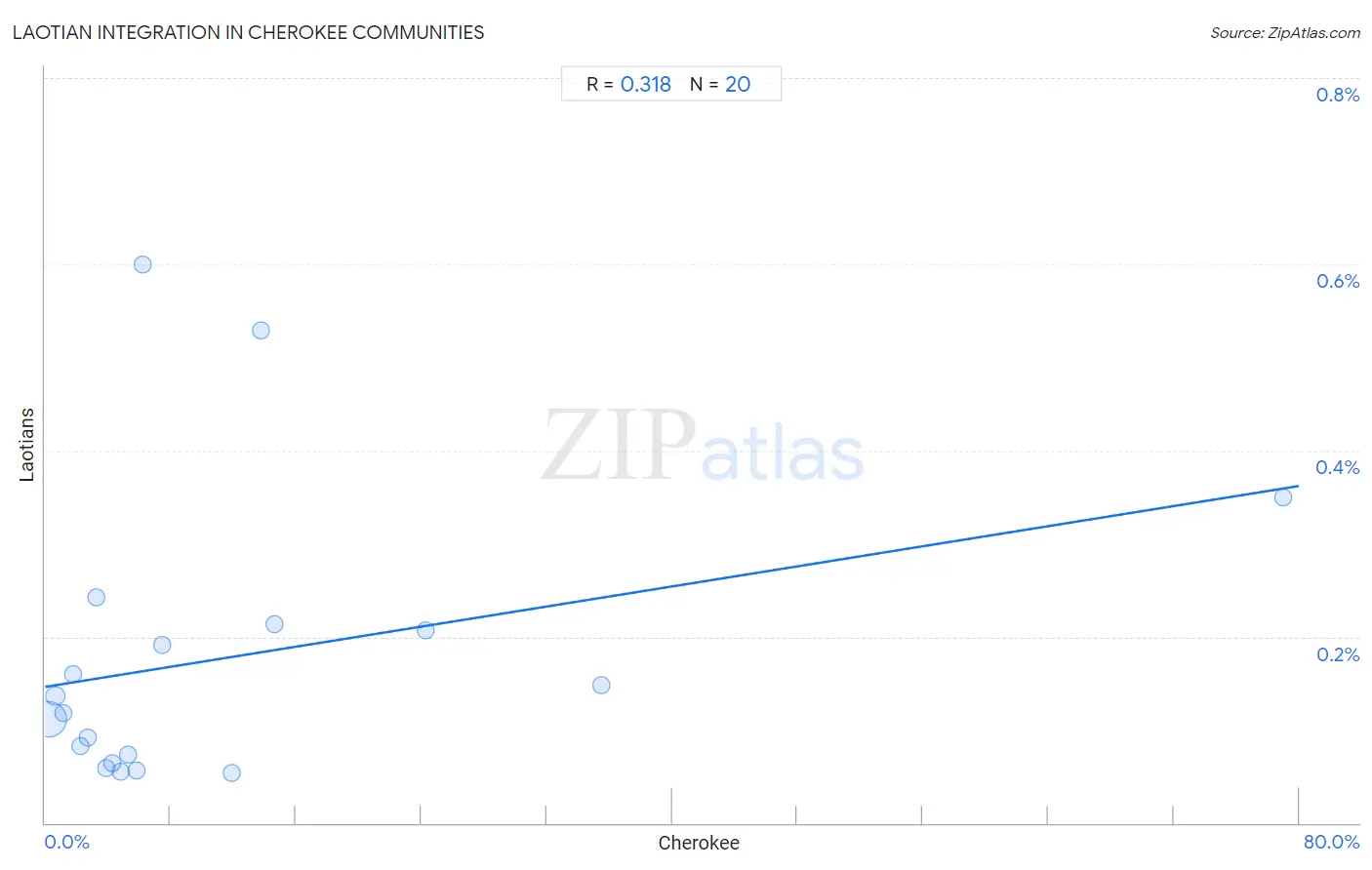
Cherokee vs Laotian Income
When considering income, the most significant differences between Cherokee and Laotian communities in the United States are seen in median household income ($72,682 compared to $94,990, a difference of 30.7%), householder income ages 25 - 44 years ($80,843 compared to $104,993, a difference of 29.9%), and householder income ages 45 - 64 years ($86,125 compared to $111,051, a difference of 28.9%). Conversely, both communities are more comparable in terms of wage/income gap (27.4% compared to 26.4%, a difference of 4.0%), householder income under 25 years ($47,848 compared to $54,369, a difference of 13.6%), and median female earnings ($34,742 compared to $42,133, a difference of 21.3%).

| Income Metric | Cherokee | Laotian |
| Per Capita Income | Tragic $37,203 | Exceptional $47,041 |
| Median Family Income | Tragic $88,209 | Exceptional $112,859 |
| Median Household Income | Tragic $72,682 | Exceptional $94,990 |
| Median Earnings | Tragic $41,252 | Exceptional $50,343 |
| Median Male Earnings | Tragic $48,669 | Exceptional $59,351 |
| Median Female Earnings | Tragic $34,742 | Exceptional $42,133 |
| Householder Age | Under 25 years | Tragic $47,848 | Exceptional $54,369 |
| Householder Age | 25 - 44 years | Tragic $80,843 | Exceptional $104,993 |
| Householder Age | 45 - 64 years | Tragic $86,125 | Exceptional $111,051 |
| Householder Age | Over 65 years | Tragic $54,133 | Exceptional $66,306 |
| Wage/Income Gap | Tragic 27.4% | Poor 26.4% |
Cherokee vs Laotian Poverty
When considering poverty, the most significant differences between Cherokee and Laotian communities in the United States are seen in child poverty under the age of 5 (21.7% compared to 14.7%, a difference of 47.4%), female poverty among 25-34 year olds (17.2% compared to 12.2%, a difference of 41.0%), and child poverty among boys under 16 (19.7% compared to 14.3%, a difference of 37.6%). Conversely, both communities are more comparable in terms of seniors poverty over the age of 75 (12.0% compared to 12.3%, a difference of 2.3%), seniors poverty over the age of 65 (11.0% compared to 10.6%, a difference of 3.4%), and female poverty among 18-24 year olds (22.7% compared to 19.2%, a difference of 17.9%).
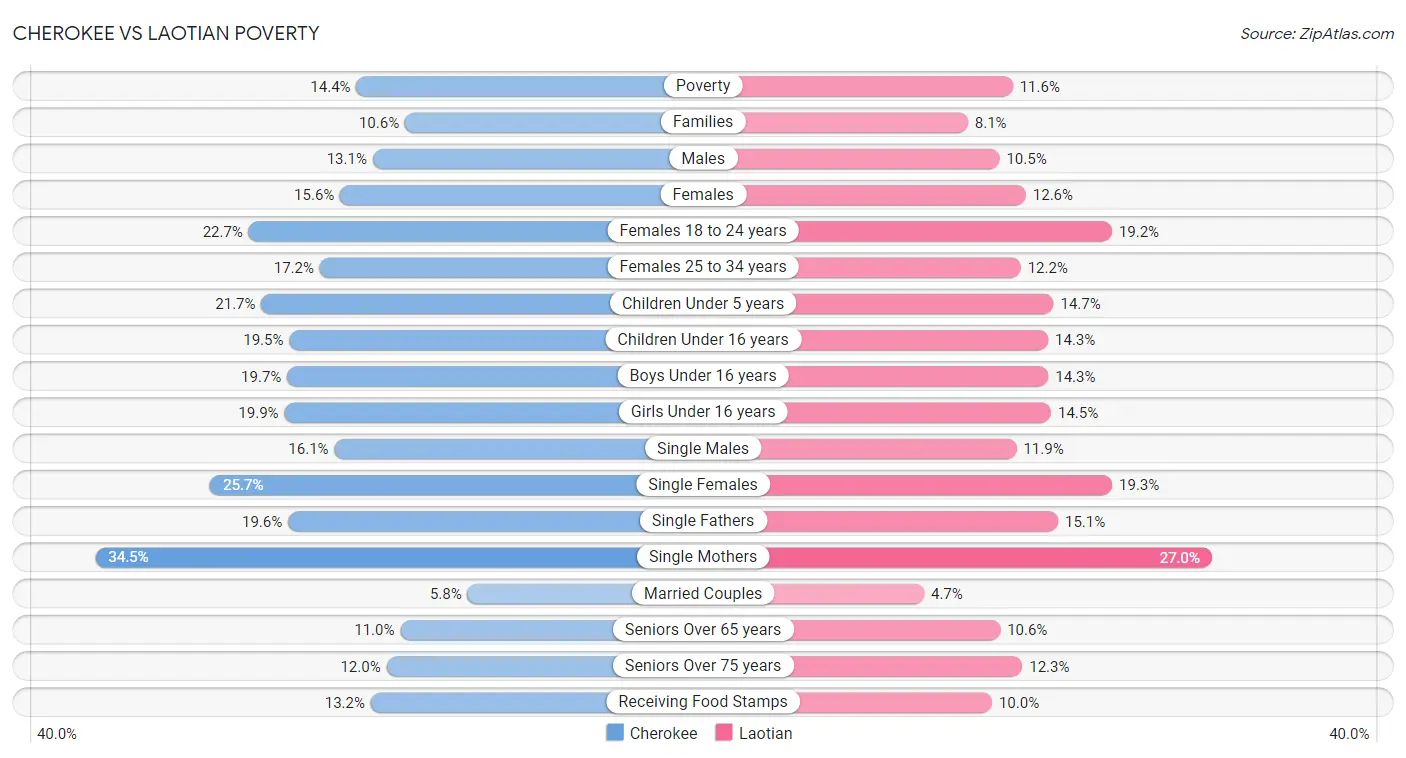
| Poverty Metric | Cherokee | Laotian |
| Poverty | Tragic 14.4% | Exceptional 11.6% |
| Families | Tragic 10.6% | Exceptional 8.1% |
| Males | Tragic 13.1% | Exceptional 10.5% |
| Females | Tragic 15.6% | Exceptional 12.6% |
| Females 18 to 24 years | Tragic 22.7% | Exceptional 19.2% |
| Females 25 to 34 years | Tragic 17.2% | Exceptional 12.2% |
| Children Under 5 years | Tragic 21.7% | Exceptional 14.7% |
| Children Under 16 years | Tragic 19.5% | Exceptional 14.3% |
| Boys Under 16 years | Tragic 19.7% | Exceptional 14.3% |
| Girls Under 16 years | Tragic 19.9% | Exceptional 14.5% |
| Single Males | Tragic 16.1% | Exceptional 11.9% |
| Single Females | Tragic 25.7% | Exceptional 19.3% |
| Single Fathers | Tragic 19.6% | Exceptional 15.1% |
| Single Mothers | Tragic 34.5% | Exceptional 27.0% |
| Married Couples | Tragic 5.8% | Exceptional 4.7% |
| Seniors Over 65 years | Average 11.0% | Good 10.6% |
| Seniors Over 75 years | Good 12.0% | Fair 12.3% |
| Receiving Food Stamps | Tragic 13.2% | Exceptional 10.0% |
Cherokee vs Laotian Unemployment
When considering unemployment, the most significant differences between Cherokee and Laotian communities in the United States are seen in unemployment among women with children under 6 years (9.3% compared to 6.5%, a difference of 42.8%), unemployment among women with children ages 6 to 17 years (10.0% compared to 7.9%, a difference of 26.8%), and unemployment among ages 30 to 34 years (6.4% compared to 5.2%, a difference of 21.9%). Conversely, both communities are more comparable in terms of female unemployment (5.3% compared to 5.3%, a difference of 0.91%), unemployment among ages 65 to 74 years (5.4% compared to 5.4%, a difference of 1.1%), and unemployment among ages 60 to 64 years (4.9% compared to 4.8%, a difference of 2.1%).
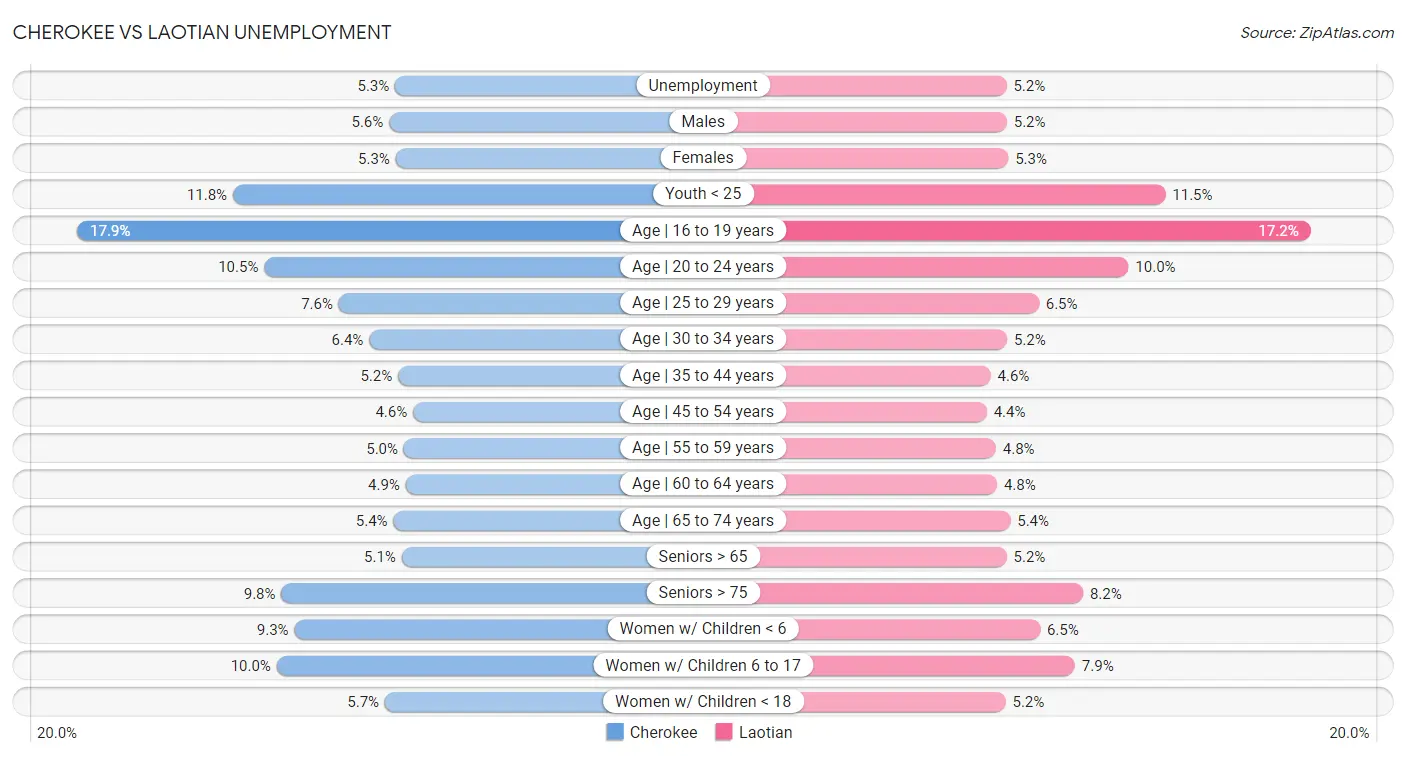
| Unemployment Metric | Cherokee | Laotian |
| Unemployment | Fair 5.3% | Good 5.2% |
| Males | Tragic 5.6% | Good 5.2% |
| Females | Fair 5.3% | Average 5.3% |
| Youth < 25 | Fair 11.8% | Good 11.5% |
| Age | 16 to 19 years | Poor 17.9% | Excellent 17.2% |
| Age | 20 to 24 years | Tragic 10.5% | Exceptional 10.0% |
| Age | 25 to 29 years | Tragic 7.6% | Excellent 6.5% |
| Age | 30 to 34 years | Tragic 6.4% | Exceptional 5.2% |
| Age | 35 to 44 years | Tragic 5.2% | Excellent 4.6% |
| Age | 45 to 54 years | Poor 4.6% | Excellent 4.4% |
| Age | 55 to 59 years | Tragic 5.0% | Good 4.8% |
| Age | 60 to 64 years | Poor 4.9% | Good 4.8% |
| Age | 65 to 74 years | Fair 5.4% | Average 5.4% |
| Seniors > 65 | Excellent 5.1% | Poor 5.2% |
| Seniors > 75 | Tragic 9.8% | Exceptional 8.2% |
| Women w/ Children < 6 | Tragic 9.3% | Exceptional 6.5% |
| Women w/ Children 6 to 17 | Tragic 10.0% | Exceptional 7.9% |
| Women w/ Children < 18 | Tragic 5.7% | Exceptional 5.2% |
Cherokee vs Laotian Labor Participation
When considering labor participation, the most significant differences between Cherokee and Laotian communities in the United States are seen in in labor force | age 16-19 (40.2% compared to 34.9%, a difference of 15.4%), in labor force | age > 16 (61.9% compared to 65.8%, a difference of 6.2%), and in labor force | age 45-54 (79.0% compared to 82.9%, a difference of 4.9%). Conversely, both communities are more comparable in terms of in labor force | age 20-24 (75.9% compared to 74.1%, a difference of 2.4%), in labor force | age 25-29 (82.1% compared to 84.4%, a difference of 2.8%), and in labor force | age 35-44 (81.4% compared to 84.2%, a difference of 3.4%).

| Labor Participation Metric | Cherokee | Laotian |
| In Labor Force | Age > 16 | Tragic 61.9% | Exceptional 65.8% |
| In Labor Force | Age 20-64 | Tragic 76.2% | Average 79.6% |
| In Labor Force | Age 16-19 | Exceptional 40.2% | Tragic 34.9% |
| In Labor Force | Age 20-24 | Exceptional 75.9% | Tragic 74.1% |
| In Labor Force | Age 25-29 | Tragic 82.1% | Poor 84.4% |
| In Labor Force | Age 30-34 | Tragic 81.6% | Average 84.7% |
| In Labor Force | Age 35-44 | Tragic 81.4% | Poor 84.2% |
| In Labor Force | Age 45-54 | Tragic 79.0% | Good 82.9% |
Cherokee vs Laotian Family Structure
When considering family structure, the most significant differences between Cherokee and Laotian communities in the United States are seen in births to unmarried women (36.7% compared to 28.5%, a difference of 28.8%), divorced or separated (13.7% compared to 11.2%, a difference of 22.6%), and single father households (2.6% compared to 2.2%, a difference of 17.6%). Conversely, both communities are more comparable in terms of currently married (46.9% compared to 47.4%, a difference of 1.1%), family households (65.0% compared to 65.8%, a difference of 1.3%), and average family size (3.18 compared to 3.26, a difference of 2.3%).

| Family Structure Metric | Cherokee | Laotian |
| Family Households | Exceptional 65.0% | Exceptional 65.8% |
| Family Households with Children | Average 27.5% | Exceptional 28.5% |
| Married-couple Households | Good 46.7% | Exceptional 48.4% |
| Average Family Size | Tragic 3.18 | Excellent 3.26 |
| Single Father Households | Tragic 2.6% | Exceptional 2.2% |
| Single Mother Households | Tragic 6.8% | Exceptional 5.8% |
| Currently Married | Good 46.9% | Excellent 47.4% |
| Divorced or Separated | Tragic 13.7% | Exceptional 11.2% |
| Births to Unmarried Women | Tragic 36.7% | Exceptional 28.5% |
Cherokee vs Laotian Vehicle Availability
When considering vehicle availability, the most significant differences between Cherokee and Laotian communities in the United States are seen in no vehicles in household (7.7% compared to 9.1%, a difference of 17.1%), 3 or more vehicles in household (23.0% compared to 21.5%, a difference of 6.9%), and 4 or more vehicles in household (7.7% compared to 7.4%, a difference of 4.9%). Conversely, both communities are more comparable in terms of 1 or more vehicles in household (92.4% compared to 91.0%, a difference of 1.5%), 2 or more vehicles in household (59.9% compared to 58.6%, a difference of 2.2%), and 4 or more vehicles in household (7.7% compared to 7.4%, a difference of 4.9%).

| Vehicle Availability Metric | Cherokee | Laotian |
| No Vehicles Available | Exceptional 7.7% | Exceptional 9.1% |
| 1+ Vehicles Available | Exceptional 92.4% | Exceptional 91.0% |
| 2+ Vehicles Available | Exceptional 59.9% | Exceptional 58.6% |
| 3+ Vehicles Available | Exceptional 23.0% | Exceptional 21.5% |
| 4+ Vehicles Available | Exceptional 7.7% | Exceptional 7.4% |
Cherokee vs Laotian Education Level
When considering education level, the most significant differences between Cherokee and Laotian communities in the United States are seen in professional degree (3.3% compared to 5.2%, a difference of 59.2%), doctorate degree (1.5% compared to 2.3%, a difference of 58.8%), and master's degree (11.4% compared to 17.0%, a difference of 49.7%). Conversely, both communities are more comparable in terms of 11th grade (92.4% compared to 92.6%, a difference of 0.14%), nursery school (98.3% compared to 97.8%, a difference of 0.54%), and kindergarten (98.3% compared to 97.8%, a difference of 0.55%).
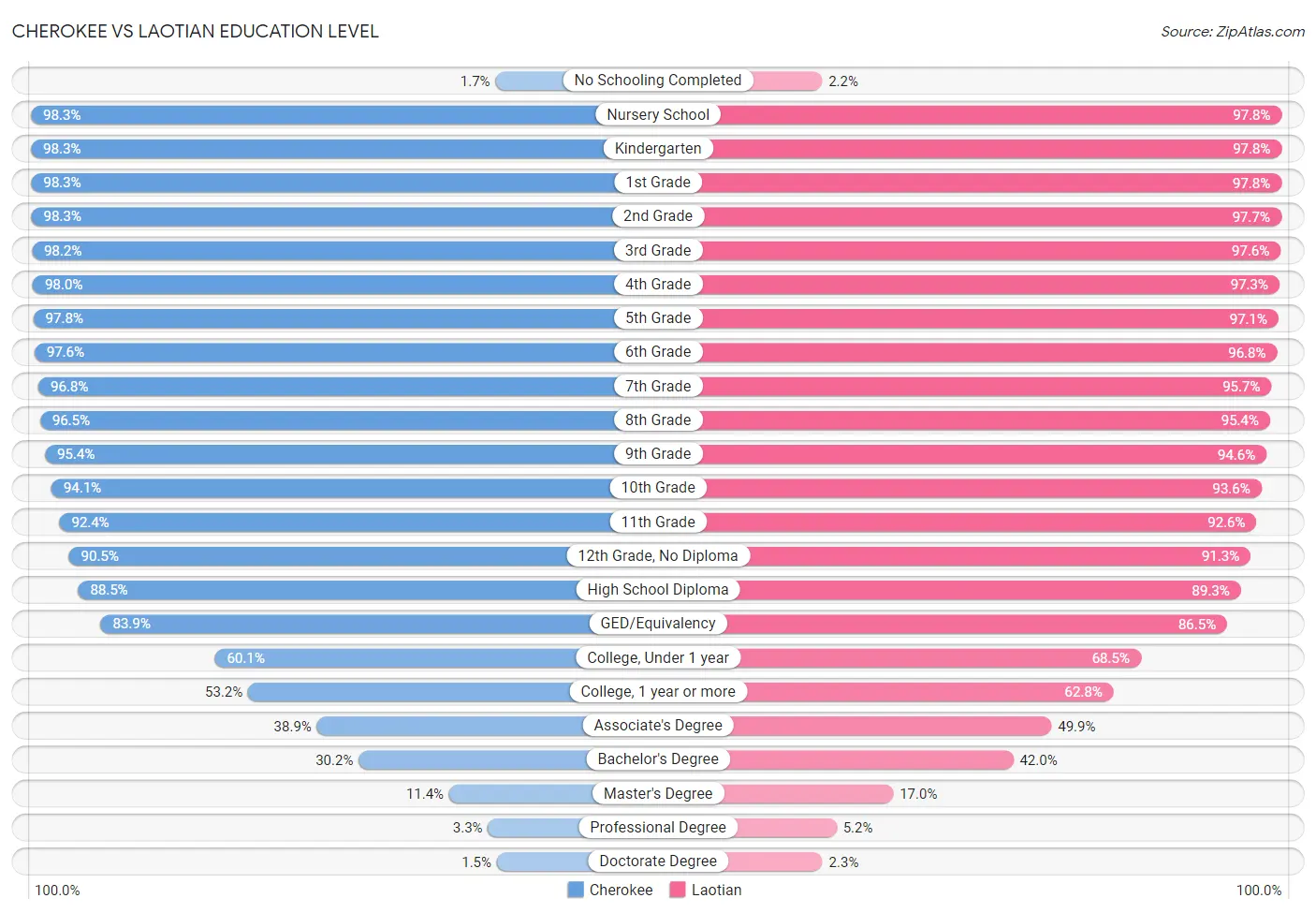
| Education Level Metric | Cherokee | Laotian |
| No Schooling Completed | Exceptional 1.7% | Poor 2.2% |
| Nursery School | Exceptional 98.3% | Tragic 97.8% |
| Kindergarten | Exceptional 98.3% | Poor 97.8% |
| 1st Grade | Exceptional 98.3% | Poor 97.8% |
| 2nd Grade | Exceptional 98.3% | Tragic 97.7% |
| 3rd Grade | Exceptional 98.2% | Tragic 97.6% |
| 4th Grade | Exceptional 98.0% | Tragic 97.3% |
| 5th Grade | Exceptional 97.8% | Poor 97.1% |
| 6th Grade | Exceptional 97.6% | Poor 96.8% |
| 7th Grade | Exceptional 96.8% | Tragic 95.7% |
| 8th Grade | Exceptional 96.5% | Tragic 95.4% |
| 9th Grade | Exceptional 95.4% | Fair 94.6% |
| 10th Grade | Excellent 94.1% | Fair 93.6% |
| 11th Grade | Average 92.4% | Average 92.6% |
| 12th Grade, No Diploma | Tragic 90.5% | Good 91.3% |
| High School Diploma | Poor 88.5% | Good 89.3% |
| GED/Equivalency | Tragic 83.9% | Excellent 86.5% |
| College, Under 1 year | Tragic 60.1% | Exceptional 68.5% |
| College, 1 year or more | Tragic 53.2% | Exceptional 62.8% |
| Associate's Degree | Tragic 38.9% | Exceptional 49.9% |
| Bachelor's Degree | Tragic 30.2% | Exceptional 42.0% |
| Master's Degree | Tragic 11.4% | Exceptional 17.0% |
| Professional Degree | Tragic 3.3% | Exceptional 5.2% |
| Doctorate Degree | Tragic 1.5% | Exceptional 2.3% |
Cherokee vs Laotian Disability
When considering disability, the most significant differences between Cherokee and Laotian communities in the United States are seen in disability age 35 to 64 (15.5% compared to 10.1%, a difference of 52.8%), vision disability (2.9% compared to 2.0%, a difference of 45.8%), and hearing disability (4.2% compared to 2.9%, a difference of 45.4%). Conversely, both communities are more comparable in terms of cognitive disability (18.0% compared to 17.3%, a difference of 4.1%), disability age over 75 (50.2% compared to 47.9%, a difference of 4.9%), and self-care disability (2.9% compared to 2.4%, a difference of 19.5%).
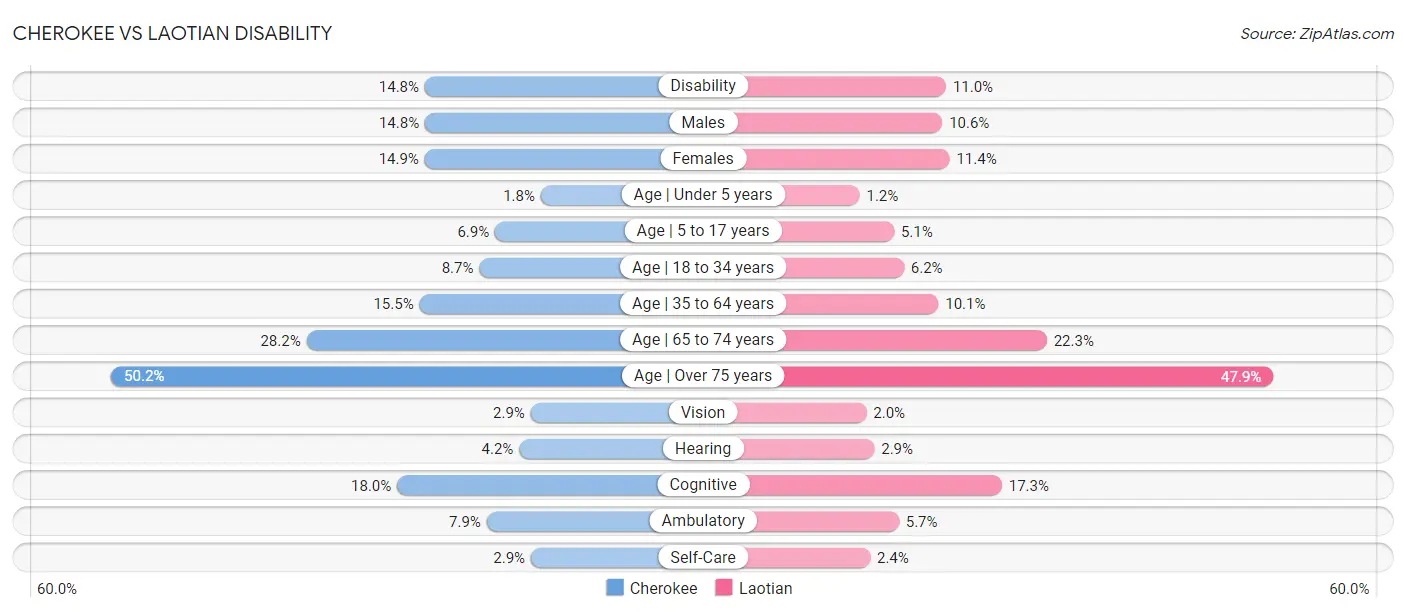
| Disability Metric | Cherokee | Laotian |
| Disability | Tragic 14.8% | Exceptional 11.0% |
| Males | Tragic 14.8% | Exceptional 10.6% |
| Females | Tragic 14.9% | Exceptional 11.4% |
| Age | Under 5 years | Tragic 1.8% | Good 1.2% |
| Age | 5 to 17 years | Tragic 6.9% | Exceptional 5.1% |
| Age | 18 to 34 years | Tragic 8.7% | Exceptional 6.2% |
| Age | 35 to 64 years | Tragic 15.5% | Exceptional 10.1% |
| Age | 65 to 74 years | Tragic 28.2% | Exceptional 22.3% |
| Age | Over 75 years | Tragic 50.2% | Poor 47.9% |
| Vision | Tragic 2.9% | Exceptional 2.0% |
| Hearing | Tragic 4.2% | Excellent 2.9% |
| Cognitive | Tragic 18.0% | Average 17.3% |
| Ambulatory | Tragic 7.9% | Exceptional 5.7% |
| Self-Care | Tragic 2.9% | Excellent 2.4% |